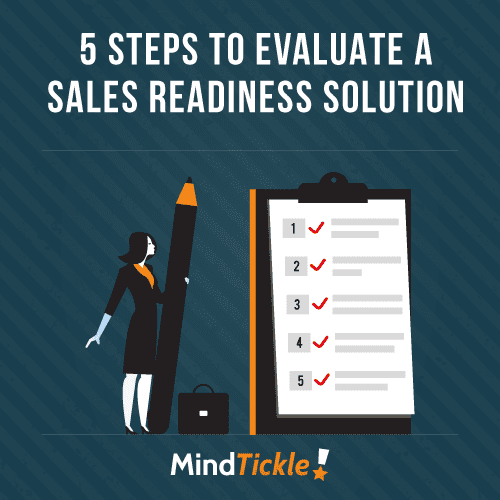 You know that sales enablement can help your sales reps be more effective at their role, but how do you know which sales enablement platform is best for you? There are so many to choose from and some have very different features, which can make comparing them confusing.
You know that sales enablement can help your sales reps be more effective at their role, but how do you know which sales enablement platform is best for you? There are so many to choose from and some have very different features, which can make comparing them confusing.
Generally, sales enablement platforms fall into two categories;
sales readiness and sales asset management
.
Sales readiness platforms help you prepare your sales reps to have meaningful conversations with their customers. Sales asset management platforms enable reps to manage their sales content. In this post, I’m going to focus in on the five steps that will help you find the right sales readiness platform for your business.
Step 1: Step back and define your objectives
While you may be eager to pick a solution and get started, it’s important to take some time to reflect on what you’re trying to achieve first. While you may feel like you’re wasting precious time, in the long run, this step will save you from making the wrong decision, and it will help you gain clarity on what your business really needs.
There isn’t a one size fits all approach to sales readiness, what your sales reps need to be sales ready may be very different from other businesses. Consider the following questions:
- What stage is your business in?If you’re scaling rapidly perhaps you’re struggling to ramp up all your new hires effectively with your current onboarding program. If you’re an established business with a large sales team perhaps you find it challenging to keep all your reps on message.
- How dynamic is your industry?If your competitors (and you) are releasing new product features every other week, then communicating regularly and keeping your reps on message is crucial to their readiness.
- How much visibility do you have on your reps’ capabilities?If you don’t have a process in place to identify skill or capability gaps then a solution that enables you to assess their capabilities would be helpful.
- Are you developing a culture of coaching and sales effectiveness?If the majority of your reps aren’t meeting quota regularly or turning over too soon then your coaching process may need more structure to give your reps the cadence they need to close more deals. Your managers may also need more support to create a culture of coaching and feedback, enabling them to focus on broader sales effectiveness, rather than just pipeline and sales skills.
- Is your business in need of a sales transformation?If you’ve recently gone through an M&A or you’ve launched a new product you may need an effective way to ensure your customer-facing team is aligned to the new messaging quickly and effectively.
- Is your current system really working?Old school LMS and classroom training sessions just don’t cut it anymore. To keep your reps engaged, achieve ROI for your sales enablement efforts and keep up with your competitors, it may be time to update your system to something that addresses the sales issues you face today.
Once you have identified your key objectives, you’re ready to move onto the next stage.
Step 2: Identify your dependencies
Your sales readiness platform is probably not the only tool in your sales stack. While all these tools are designed to make life easier for your sales team, they can actually make it more challenging if they’re not integrated. After all, how many logins can you remember?
That’s why it’s a good idea to identify what tools or platforms you would like your sales readiness platform to talk to. Would reporting be easier if your sales readiness platform could report based on the categories in your CRM? Would your sales reps find it useful if your sales readiness tool could help them identify contextual content for customer conversations from your sales asset management tool?
By including this level of integration on your wishlist you can narrow down the sales readiness platforms that best suit your needs.
Step 3: Prioritize what’s important
This is where the objectives you identified in step 1 become important. They should drive the features and functionalities that you need the most from your sales readiness platform. It’s helpful to identify what your priorities are using a basic framework and then listing out the key elements that your business needs under each category. I suggest using a framework that includes knowledge enablement, skill development, scenario-based training, analytics and other features:
Knowledge Enablement:
This refers to the ability of your reps to use knowledge in the context of their sales situations.
Feature: Learning modules
You need this if you want to
-
- Assign modules to personalize learning tracks for different learners or groups.
- Selectively invite individuals and groups to learning modules.
Feature: Mobile app and bite-sized content files
You need this if you want to
-
- Share regular updates on new product features, competitive insights, success stories and marketing collateral in real time.
Feature: Assessments and Certifications
You need this if you want to
-
- Customize benchmarks or pass scores for goal-based assessments.
- Generate and award certificates to reps when they complete a level.
Feature: Flexible content formats
You need this if you want to
-
- Import content from other sources (like Dropbox, Google Drive, Slideshare or Youtube).
- Directly upload or amend content in any file format.
- Create short and long form training content.
Feature: Quick quizzes
You need this if you want to
-
- Measure knowledge retention with pop quizzes and reinforce key information.
- Intertwine quizzes with content for effective reinforcement.
- Conduct timed quizzes and randomize questions.
Feature: Easy content search and discovery
You need this if you want to
-
- Enable your reps to be able to find content easily when they need it.
- Ensure your reps can bookmark content so they can access easily.
- Enable content to be saved offline so they can find it anytime.
Feature: Gamification
You need this if you want to
-
- Drive adoption and ensure your sales reps actually use the platform and even enjoy using it.
- Customize rewards based on content importance.
Feature: Integration with other systems
You need this if you want to
-
- Integrate with your sales asset management tool so you can enable your reps to access content that is relevant to their specific situation at the time they need it most.
- Integrate with your CRM so you can leverage the segmentation and team profiles you have created there for analytics or to allocate learning tracks.
- Integrate with HR systems so you can leverage the team and individual profiles you have created there for analytics or to allocate learning tracks.
Skill development:
These features help your reps handle specific sales scenarios.
Feature: Structured coaching
You need this if you want to:
-
- Enable contextual coaching so managers can objectively observe reps while they are in their sales motion. They can then provide feedback and training and support reps when navigating complex sales scenarios in real time.
- Give your manager the ability to conduct on-the-job coaching, even when they’re in a different location to their reps. They can observe and rate how reps perform their sales activities
Scenario-based training:
These features help your reps execute your plan through coaching. This teaches them to follow the sales process and even receive specific feedback on their deals.
Feature: Video / audio role plays
You need this if you want to:
-
- Help your reps practice how they respond to specific and contextual sales situations.
- Ensure your reps are articulating your product value proposition consistently, know how to demo your product or can deliver a compelling elevator pitch.
- Enable managers to review video, voice over powerpoint, voiceover screen capture and audio responses in real time.
- Enable managers to review and grade email responses and offline learning.
- Customize evaluation parameters for role plays.
Feature: Automated workflows
You need this if you want to:
-
- Enable your sales managers, sales enablement or other team members to provide qualitative and quantitative feedback on the video or audio recordings your reps submit.
- Create accountability and a cadence for coaching, so it becomes something that your managers and reps do every day.
Feature: Best practices library
You need this if you want to:
-
- Share best practices and success stories across your team and facilitate peer to peer learning.
Feature: Contextual remediation
You need this if you want to:
-
- Suggest training tracks to reps based on identified knowledge or skill gaps.
- Automate training based on gaps identified by their manager.
Analytics:
These features help you drive accountability, identify knowledge and skill gaps, and report back to sales managers and leaders.
Feature: Drill down views and reports
You need this if you want to:
-
- Measure and track the engagement and retention of each rep, sales team or region.
- Track cohorts (based on their onboarding batch, sales kickoff attendance etc) to see how each has performed against other cohorts.
- Export user data into Salesforce.
Feature: Reporting on content effectiveness
You need this if you want to:
-
- Identify which content has an impact on your reps’ performance and which do not.
Feature: Reporting on business impact
You need this if you want to:
-
- Correlate sales enablement activities with business outcomes. This will help demonstrate the impact on revenue of initiatives or improvements in capability.
Other priorities
Aside from features, there are several other questions that you may want to ask a vendor including:
- What is their roadmap in terms of product enhancements and expansions?
- What are the minimum software/hardware requirements to use the solution?
- What are the solution’s implementation strategy and process?
- How long will the implementation process take?
- How much of your support is typically required during implementation?
- What Is Customer Success support available after implementation?
Step 4: Evaluate platforms against your priorities
It may be tempting to just pick the first platform you demo but it may not have everything you need. It’s important to at least compare two or three sales readiness platforms so you can see just how different they are. By listing out the criteria that are your priorities, and then assessing each platform against that criteria, you can objectively identify which platform will best meet your needs.
Step 5: Get feedback or read reviews
Once you’ve identified the sales readiness platform that best meets your needs, it’s always helpful to hear from people who actually use the product. This is actually easier to do than you may realize. Websites like G2 Crowd allow users to provide unbiased reviews of software platforms they’ve used in real time. You can see how people rated different aspects of each platform and read their comments about what it’s like to use the tool.
While it may sound daunting, by taking a little extra time to evaluate and choose the right sales readiness platform you will save yourself a lot of time and effort in the long run.







